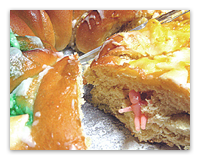History behind the King Cake
As part of the Christian faith, the coming of the wise men bearing gifts to the Christ Child is celebrated twelve days after Christmas. We refer to this as the Feast of the Epiphany or Little Christmas on the Twelfth Night. This is a time of celebration, exchanging gifts and feasting. Today, the tradition continues as people all over the world gather for festive Twelfth Night celebrations. A popular custom was and still is the baking of a special cake in honor of the three kings called “A King’s Cake.”

Inside every cake is a tiny baby (generally plastic now, but sometimes this baby might be made of porcelain or even gold). The tradition of having King Cake Parties has evolved through time, and the person who receives the slice of cake with the baby is asked to continue the festivities by hosting the next King Cake party.
Originally, King Cakes were a simple ring of dough with a small amount of decoration. Today's King Cakes are much more festive. After the rich Danish dough is braided and baked, the “baby” is inserted. The top of the ring or oval cake is then covered with delicious sugar toppings in the traditional Mardi Gras colors of purple, green and gold.
In more recent years, some bakeries have been creative with stuffing and topping their cakes with different flavors of cream cheese and fruit fillings.
January 6, the Twelfth Night after Christmas, is also the day our Mardi Gras season begins. Mardi Gras Day is always 47 days prior to Easter Sunday (Fat Tuesday is always the day before Ash Wednesday).
So, in Louisiana especially, Mardi Gras season and King Cakes go hand in hand with literally hundreds of thousands of King Cakes consumed at parties and office lunch rooms every year.
Ordering King Cakes over the internet has now become an annual tradition by consumers all around the world - and many of our bakers offer them year round. After all, you can’t have a Mardi Gras party without a King Cake!

 Find the baby and you’re the King or Queen of the day! It’s a dubious honor, however, as the King or Queen is usually obligated to supply the next king cake or host the next party or both.
Find the baby and you’re the King or Queen of the day! It’s a dubious honor, however, as the King or Queen is usually obligated to supply the next king cake or host the next party or both.  Originally, King Cakes were a simple ring of dough with a small amount of decoration. After the rich Danish dough is braided and baked, the “baby” is inserted. The top of the ring or oval cake is then covered with delicious sugar toppings in the traditional Mardi Gras colors of purple, green and gold.
Originally, King Cakes were a simple ring of dough with a small amount of decoration. After the rich Danish dough is braided and baked, the “baby” is inserted. The top of the ring or oval cake is then covered with delicious sugar toppings in the traditional Mardi Gras colors of purple, green and gold.